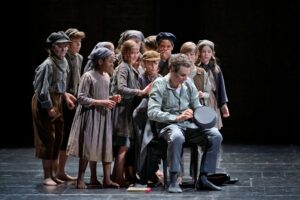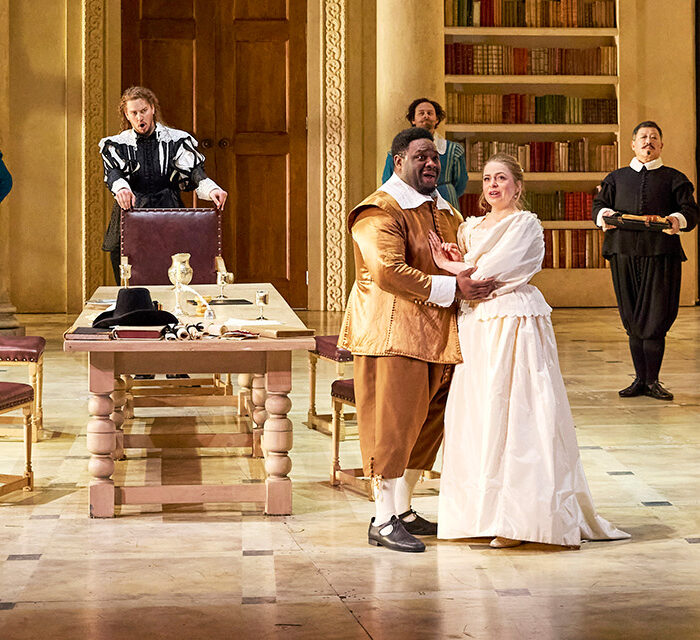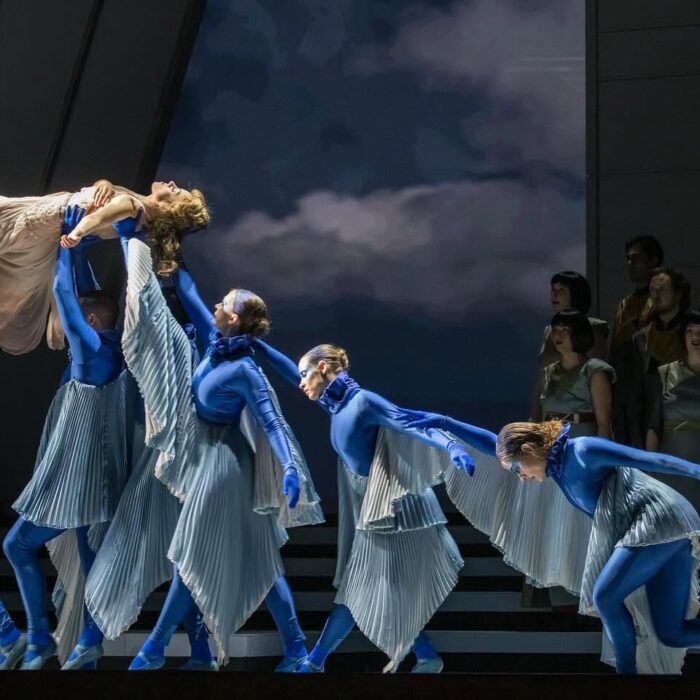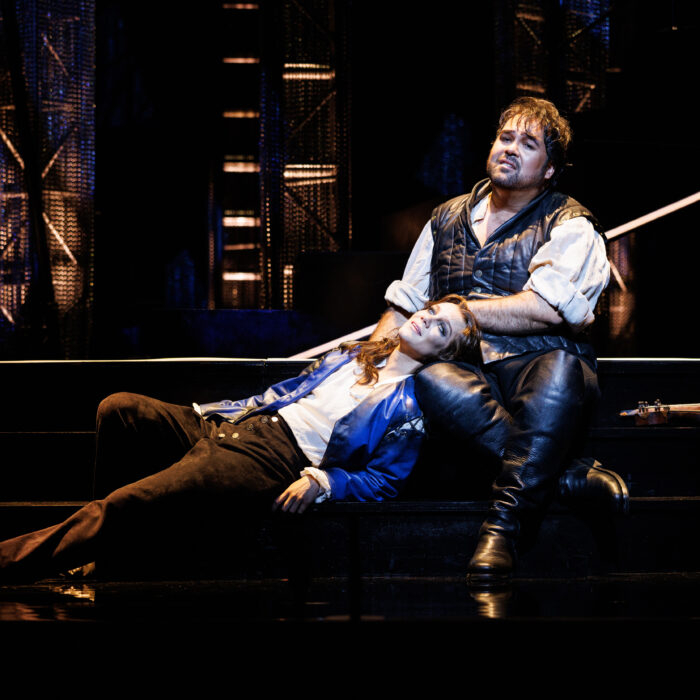
Opéra Comique 2022-23 Review: Carmen
Gaëlle Arquez Puts on Star Turn in Unforgettable Production
By João Marcos CopertinoConductor Louis Langrée once explained the ‘Opéra-Comique’ in these terms: “The Opéra-Comique comes from fairground theater, which is its strength.” Looking at the company’s many successes in bringing great operas into its repertoire—“Pelléas etMélisande,” “Mignon,” “Manon Lescaut”—, it seems that Langrée is right. “Carmen,” however, would at first appear to be a bit different. It is, by far, the most performed French opera of all time—and Opéra-Comique’s biggest hit.
The music of “Carmen” is so great that, as Langrée himself reminds us, even a person who has never seen any opera knows most of “Carmen’s” melodies. How can fairground theater flourish in an opera that is mainly defined by its unforgettable music?
A Daring New Interpretation of a Classic
Stage director Andreas Homoki undertakes the hard task of making “Carmen’s” theater as indelible as its music. In the big return of “Carmen” to Opéra-Comique—the opera was last performed there in 2009—, the opera becomes a reflection on desire and representation, but also a somewhat self-indulgent homage to the space of Opéra-Comique itself. Maybe Homoki’s smartest decision was to cast the audience as a character in “Carmen.” In the first scene, the lights of the theater are all on and the chorus, dressed as the bourgeoisie of 1875, admonishes us, the operagoers: “Sur la place chacun passe, chacun vient, chacun va; drôles de gens que ces gens-là!”
“Carmen,” this gesture reminds us, is the landmark. The audience is transitory.
The opera and its characters endure. The scenery—by Homoki and Paul Zoller—consists of a series of curtains that open and close, as if they themselves were in a continuous search for that immeasurable theatrical power that is “Carmen.” The characters, too, are sometimes left outside the theater, trying to get in. With such an empty stage, most of the drama is embedded in the terrific costumes by Gideon Davey, and incredible lighting by Franck Evin. Their work gives us clues for decoding who is a part of the perennial “Carmen” and who is merely part of the ephemeral audience.
Don José, at first, is an audience member: he represents the basic man of our times, and first appears milling around on stage in modern clothes. Only with his immersion into the world of “Carmen” does he become a character: one who lives out his own fateful desire, and accepts the due consequences of his actions. Carmen herself both is and is not part of this theater. It seems that Homoki’s vision for Carmen—and, to an even greater degree, Escamillo—is closer to her musical persona, drawing her further away from a felt physical presence onstage. Carmen is more aware of her looming death than is her assassin, while Escamillo, in his song of self-praise, tells us that in the arena a bullfighter must be attentive, “Et songe bien, oui, songe en combattant, qu’un œil noir te regarde et que l’amour t’attend!” There is an ambiguity to Escamillo’s words. What eyes wait for him? Carmen’s? The bull’s? In Homoki’s production these possibilities fuse with the audience, who also watches him.
In a “Carmen” where Don José is made a bigger character than the eponymous protagonist, the Roma woman becomes the locus for a series of subtle ambiguities. Carmen is a “lesser” character in the sense that she is hardly a character at all, becoming instead music itself. She enacts, perhaps self-consciously, the knowledge that her name means ‘song.’ Here, Carmen—music herself—is aware even that she sings, and that there is an orchestra in the pit. Usually, in opera, the characters are supposed to be deaf to the orchestra. Opéra-Comique’s “Carmen,” however, presents a couple of moments in which such a premise is challenged. Homoki distills as much enjoyment as he can from these moments, and it seems to me that Gaëlle Arquez—the French mezzo-soprano who embodies the titular role—does, too. In her “Près des remparts de Séville,” Arquez uttered her “oui” instead of singing it. Don José demands that she not speak to him, and she claims that she was just singing to herself. But both she and we know that this is not true: she speaks to us, and to him, as well. Whatever she may say at the end of the opera, she can, in fact, lie.
When Homoki turns on all the lights in the house once more, he turns the words of the chorus into a form of advice to the audience: “Écoute, écoute, compagnon, écoute, la fortune est là-bas, là-bas, mais prends garde pendant la route, prends garde de faire un faux pas!” (“Hark, hark, wayfarer, hark fortune is there, but pay attention to the route, pay attention to not misstep!”). Advising us, the non-theatrical people, to watch our step, Homoki implies that we may not be as aware as we should be of the consequences that repressed desire may have.
The drama heightens when Homoki ends the action in the third act. The fourth act becomes a reflection upon the theater we have just seen. The toreador parade is televised. The bourgeoisie from the first three acts are gone. Even the theater has somehow ended: now it is mass-media. We all watch the theater on the small screen. But Don José cannot face that, as Carmen well knows. He murders her, still uncertain of his theatrical place. He says, seemingly to the audience—for the stage is bare—, “you can arrest me,” but nobody comes.
A Captivating Cast
This production included almost all those parts of the score that are so often cut nowadays. It was a delight to hear all the moments from the orchestra and chorus that are usually edited out. Even better was to hear all the dialogue, which enhanced the experience of “Carmen,” making it ever more intriguing and thought-provoking. A complaint often heard is that the singers were not audible over the orchestra. In this “Carmen,” the situation was completely reversed: sometimes it was the orchestra that was made inaudible by the singers’ powerful voices. Progressively through the night the situation improved. But it is amusing to see that “Carmen,” returning to Opéra-Comique and its theater of origin, finds a room as challenging as any of the other theaters to which it has traveled for a craftier and more intimate approach to the music.
Gaëlle Arquez is one of the greatest specialists for the role. When one sees her onstage, one see why. Her voice, with its rich, lower harmonics, suits the role well, and brings out her great enunciation in the spoken dialogues. At a few moments Arquez gives to Carmen a sense of adolescence—even girliness—that upends the usual treatment of her as an inhuman monument to freedom and will. In the second act, confronted by the demands of Remendado and Dancaïre to join in their smuggling, Carmen sings and speaks with a lighter tone, as if at that moment she could still be happy with Don José. Arquez’s voice is adult and big, however. She pays particular attention to the consonants in the French language. Some articulations are almost erotically inflected, as she enjoys every bit of the word.
Arquez understands her voice evokes music that, though it comes from the orchestra, still needs her as an oracle to tell us its meaning. She has a very generous voice, but she does face some limits to her tessiture in the “Card Trio.” Her confrontation with her fateful death is musically illustrated by her encounter with her vocal limits. Arquez is a Carmen performer to be remembered.
Quebecois tenor Frédéric Antoun gives a good characterization of Don José and good musical phrasing. His instrument shows some inconsistencies, however. Antoun cannot properly homogenize his singing and speaking voices, which is an essential aspect of an opera-comique. When speaking, his voice is clear and uncovered, occasionally juvenile; but the singing has an unfocused lower sound that hinders much of the vocal beauty. A good opera singer is made not only of voice but of artistry and musicality, however. Antoun displays some of all, with great attention to his phrasing, especially in the third and fourth act of the opera. His ‘vous pouvez m’arrêter’ was moving.
Kosovar soprano Elbenita Kajtazi gives this production a charismatic Micaëla. Her participation in the opera, stage-wise, is expanded beyond what is usual, and her voice has a lyrical strength that is distinct from other sopranos who have sung the role. I must say that everything was particularly loud in the “Parle-moi de ma mère” duo, but what Kajtazi lacks in more nuanced colors in the pianissimos she more than compensates for with a great sense of text and rubato. Her aria, “Je dis, que rien ne m’épouvante,” was a bit rushed at the start, but ended with a beautifully stretched “Protégé-moi,” without neglecting the rolled ‘r’s.’ It was there that she won over the audience.
French bass-baritone Jean-Fernand Setti’s Escamillo has a generous voice and great pronunciation: his ‘t’s’ were perfectly pronounced. It is hard to exaggerate how potent his voice sounded in Salle Favart, but it is was also notable that, progressively, Setti’s voice evoked the silence of the bullfighting arena. His duo in the fourth act had good pianos and showed the promise of a singer who will seen on the stages of Paris again.
The parts for the smuggler group are divided between Aliénor Feix, Norma Nahoun, Matthieu Walendzik, and Paco Garcia. Together they conquered the hard quintet of the second act. In fact, for the first time in many years, I could hear the complex rhythms of the quintet, with the consonants articulated in the correct places. Jean-Christophe Lanièce’s more sober approach to Moralès works well too. There was remarkable singing by the Maîtrise Populaire de l’Opéra-Comique, conducted by Sarah Koné, as the child soldiers. The adult choir, Accentus, were also great in their scenic and vocal participations.
Louis Langrée conducted the Orchestre des Champs-Elysées with much energy and fast tempi. New layers to Bizet’s music were uncovered many times over the course of the performance. There were clearly well-considered musical ideas there, but the execution was also full of mistakes. Langrée often rushed the tempi a bit too much, and the singers could not end their musical phrases elegantly. More than once there were issues with synchrony between stage and orchestra, and the flautist was clearly not having their best day in the third act duo. More than once their breathing was louder than their playing, cutting the flute phrases in half.
All these musical mishaps, however, did not prevent the orchestra from conveying the great joy of Bizet’s music. Whatever the technical difficulties, this “Carmen” production—and Langrée’s musical reading of the score—has an original sense of joy. It brings meaning and life to an opera that sounds new even though everyone already knows it by heart.
At the end of the night, one might be left wondering whether the staging made sense; whether the singers were too loud; and even whether the femicide at the end of the opera is still necessary. One thing is certain, however: no-one will react to Opéra-Comique’s “Carmen” with indifference. It does not shock audiences with coup-de-theatres or vulgarities, but it invites us to see the life within the score with fresh eyes. It encourages us to pay attention to everything that can be heard therein, even if conclusions may still elude us. It makes for a night of opera that compels us to discuss it with friends, attempting to explain it to one-another and to ourselves. Time and again you want to ask, filled with delight and mystery: what actually happened?
Somehow “Carmen” remains wildly popular while still preserving its enigma. We love the protagonist as we do the opera, and we want her to tell us all her secrets. She soberly look at our eyes and says, “coupe-moi, brûle-moi, je ne te dirai rien” (“cut me, burn me, I will not say a thing”).


